
Der Plan’s “Geri
Reig” was mentioned in these pages about a year ago when the fantastic Bureau B
label reissued this debut album of 1980 along with other Ata Tak releases from
the period. Now, are there any others on the way and are the next two Andreas
Dorau albums, the ones he released on Motor in the nineties, going to get the
same lavish BB treatment, one has to wonder, nay entreat. It’s turning into a
long wait, this one, made all the more frustrating by there being no guarantee
of an outcome.
Anyway, to get to the
point, a vinyl copy of the aforementioned album has made its presence felt at
German Bite/Friedrich Strasse HQ for many years, its odd title serving to
greatly perplex over time. OK, it’s a homemade genre of music, perhaps
exclusive to the band, I gathered, but how do you pronounce these words? Geri
with a hard ‘G’ as in “Du bist gegen Gegen” by Cyberbeatnix or with a soft
beginning as in ‘Germany’ or “Jerry”, the wartime nickname given to those from
whom Der Plan descend. In fact, is this latter word the origin exactly for the
first of this confusing pairing and, as for its partner, is this a one or two
syllable entity? Taken phonetically, are we being introduced to a post-punk,
synthetic, LSD infused German interpretation of reggae? Certainly, amongst all
the twisting, reversing, speeding up and slowing down, sometimes spooky,
sometimes kindergarten-sounding madness of the album, the rhythm can get a little
bit springy at times. Nowhere is this more obvious, actually, than on the album’s
title track where the words “reggae reggae”, in true Levi Roots style, are
repeated over and over in a kind of duet performed by what sounds like one of
Alvin and the Chipmunks and an altogether less cutesy counterpart.

Pulling to hand an
English-German dictionary and doing a little research serves to shed some additional
light. For example, scour the pages of Jürgen Teipel’s indispensible oral
history of the punk and post-punk scene in Deutschland “Verschwende Deine
Jugend” (to the uninitiated out there, it’s like a German “Please Kill Me”),
for anything Der Plan related and a crumb or two mehr can be found. Here, in a
little section midway through, all three of those who would eventually
crystallise into the trio we know and love speak of their original intentions.
Frank Fenstermacher goes first, talking about how they wanted to inject a humorous
element into their music, this going against the grain of the prevailing “all
must be earnest” doctrine of the day. Pyrolator comes next, explaining briefly
how the band’s members committed punk suicide by publicly declaring their love
of the music produced by 1950s/early 1960s teen film starlet Cornelia Froboess
who’d had her first hit in 1951 at the age of eight with a song her father wrote
called “Pack Your Swimsuit”. They’d also grown rather fond of things like
airport and elevator music and decided that what they were going to produce
would be completely different from the efforts of everybody else. Then Moritz
R®, who it emerges was the main instigator of all this, speaks of wanting, like
a lot of those on the scene over there at the time, to break away from the
American tradition that had dominated pop music in Germany for so long.
However, this didn’t just mean refusing to sing in English, as was the stance
made by many, but also to try to produce music that sounded German, too.
Dismissing the popular Schlager genre as too laden with transatlantic influences,
he came to the realisation that only nursery rhymes fully reflected the nation’s
traditions and that this, in fact, was no bad thing as it corresponded nicely
with ideas he’d brought back from a visit, rather ironically perhaps, to
America where he’d been involved in making primitive music using the likes of
plastic bowls. This, he and friends had christened “jerry reeg”, to improvise
through the use of makeshift, patched-up and temporary devices. So, armed with
this philosophy, viele tabs of acid, messages transmitted to them by the dead during
trippy midnight walks in local cemeteries and a little problem still to solve regarding
which of them was going to sing, they set about recording their album.
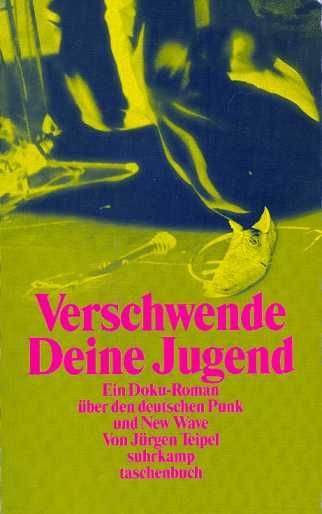
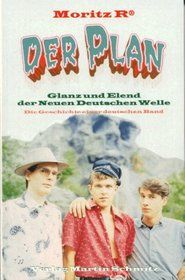
Open up Moritz R®’s
own autobiography, “Der Plan: The Splendour and Misery of The Neuen Deutschen
Welle” and you will find a short chapter titled “Amerika, California and
Disneyland” in which more detail of his aforementioned visit to the US of A is
recounted. He begins by telling us that he’d travelled via London, where he’d
visited Genesis P-Orridge at Beck Road and played him the earliest Der Plan
recordings, hoping he’d agree to releasing them on Industrial Records. His host
seems to have been reasonably receptive, but not that receptive, and a similar
visit to Green Gartside of Shitty Politti revealed that his boat was definitely
not floated by what he heard. A Residents badge was bought there, I’ve subsequently
found out, and once stateside, courtesy of Freddie Laker, it seems our hero was
spotted at San Francisco’s Deaf Club by a young couple who were impressed by
this seemingly insider item pinned to his shirt and, introducing themselves,
they invited him to stay with them in San Jose, an offer he summarily took up,
seemingly to their surprise once her arrived. The story then goes that the initial frost
caused by this faux-pas was melted when conversation turned to music and the
Americans (Greg, Cindy, Pete and Sharon) were impressed by the first of the two
visits Herr Reichelt told them he had made whilst in London. Greg, it seems,
then rebounded the wow-impact by talking of Geri-Reig a new style of music he’d
devised which was produced by using the simplest of means, the name deriving from
the process of jerry-rigging, improvising or making use of something
temporarily repaired. This struck a chord with their visitor’s already
percolating ideas and when he returned back home to Germany he was keen proselytise.
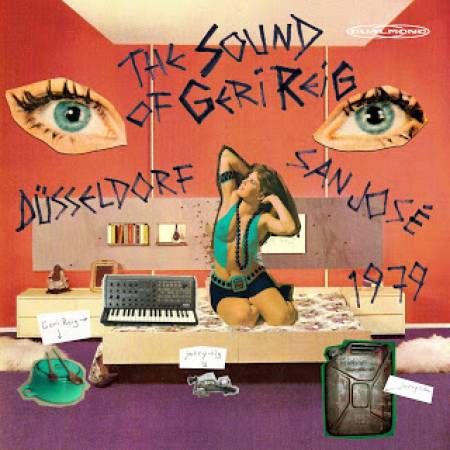
This
is all very helpful, indeed, and even more helpful was the recent release of an
album “The Sound of Geri Reig”, on the brilliantly named Kernkrach label, which
finally puts the mystery to bed and reveals a whole host more besides. However,
before we get back on to the story and then the music, let’s get the definition
straight, as casting your eyes to the top right-hand corner of the album’s back
sleeve, you find two complimentary definitions which I make no apology, given
the circumstances, for quoting in full.
1. Jerry-rig: to fix or put together using non-standard or improvised materials. A derivation of jury-rig, from the nautical term jury mast. This term refers to a temporary mast raised when the normal mast has been lost due to storm or battle. This is probably a short form of injury mast. Not to be confused with Jerry-built, which refers to an original construction of poor quality.
2. Jerry-rig: To fix an object (usually mechanical) to a working condition in a haphazard way. Also known as doing a MacGyver on it. This can apply to any non working thing, to fix it in a nonconventional way. This term was created during WW2, in reference to the Germans who were referred to as "Jerries" as slang. Allies often came across hastily repaired objects left by the Germans hence the term Jerry-Rig came to be.
1. Jerry-rig: to fix or put together using non-standard or improvised materials. A derivation of jury-rig, from the nautical term jury mast. This term refers to a temporary mast raised when the normal mast has been lost due to storm or battle. This is probably a short form of injury mast. Not to be confused with Jerry-built, which refers to an original construction of poor quality.
2. Jerry-rig: To fix an object (usually mechanical) to a working condition in a haphazard way. Also known as doing a MacGyver on it. This can apply to any non working thing, to fix it in a nonconventional way. This term was created during WW2, in reference to the Germans who were referred to as "Jerries" as slang. Allies often came across hastily repaired objects left by the Germans hence the term Jerry-Rig came to be.
Relocate your peepers
onto the other side of the back cover and below the head of a child happily
entranced by the live sounds of Geri Reig, a panel of text tells the story from
above with greater clarity and accuracy of detail, one assumes. It begins by
stating: “When Greg Oropeza and Sharon Nicol coined the term ‘Geri-Reig’ in the
hot summer of 1979, they were thinking of a music so totally home-made with the
simplest of tools you could find in any kitchen and toy instruments from your
still operational children’s room, that the result would be completely novelty(sic.)
for its lack of musical professionalism. Performed by uneducated youngsters in
virgin innocence it would also expose the unruliness of youth in its pure
natural state.” It sounds a bit like Jean-Jacques Rousseau crossed with the
punk d.i.y. ethos, to me. Listening to The Ventures, never a bad idea, says I,
and banging cooking pots with wooden spoons became their order of the day. The
Residents badge story is then re-told, although the location has now shifted
from The Deaf Club to The Mabuhay Gardens. The Düsseldorf connection we’re then
told was forged over “two kinky mind-boggling weeks” they spent together often “sitting
on giant concrete bank reinforcement tetrapods of the docks of Santa Cruz, high
on acid, eating a pineapple together and being surrounded by a surreal scene of
nightly biker gatherings.” They vowed there and then to make the concept of
Geri-Reig a reality and this they did, rather less ambitiously on one side of
the Atlantic than the other, history suggests.
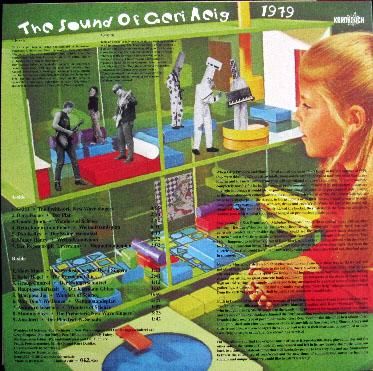
“The Sound of
Geri-Reig” gathers together sixteen examples of recordings surviving from the
period, flip-flopping pretty much throughout from San Jose to Düsseldorf
and back again as the listener progresses across the album’s two sides. They’re
introduced, it at first appears, to six different bands plus one collaboration,
some of the recordings rawer than others and, one assumes, often captured by
basic means. However, read the small print and you’ll find that, really, there
are just two bands featured as: Wonders of Science, The Prehistoric New Wave
Singers and Der Swingerschnitzel are Greg Oropeza, Sharon Nicol, Pete Millman
and Cindy Fahey; Der Karmann Ghias, Weltsaufstandsplan and Der Plan are Frank
Fenstermacher, Moritz R and Kurt Dahlke.
So, what of the music? The American contribution is
much more primitive, it quickly becomes evident, whilst the German one,
unsurprisingly, is more technologically infused, through the inclusion of
Pyrolator’s Korg MS-20, an instrument seemingly ubiquitous on the country’s new
wave scene at the time. “54321” by The Prehistoric New Wave Singers is a short
ditty which opens the shebang, combining Manfred Mann with a Three Stooges
nerdiness, also bringing the efforts of the Wiggin sisters, released under the
name of The Shaggs, to mind, as well as the spirit of the Kasenetz-Katz / Ohio
Express / 1910 Fruitgum Co. empire. Then the rhythmic, shape-shifting squelch
of the Germans first appears in the form of the instrumental “Dark Porno” which featured as a bonus track on the Bureau B re-issue referred to several
paragraphs ago. “Gondo Jundi” by Wonders of Science could be the product of the
same band, although pianos, a bass guitar, plastic-sounding drums and the
contents of the cutlery drawer sound to have been brought together in its
making. Like a lot of the songs on here, The Residents are clearly an
influence, as it sounds as though it could be a nascent outtake from either “Third
Reich and Roll” or any other of those early albums, this being unsurprising
given the button badge which had brought these people together. Moritz R® also
tells us in his book that he’d made a pilgrimage to his heroes’ San Francisco
HQ prior to his San Jose sojourn. Weltaufstandsplan are a more tripped-out, less
disciplined, if such a thing is possible, incarnation of what was to follow and
tracks like “Heinz, Komm Zum Feuer” make for quite creepy, un-easy listening, this
one probably resulting from those “trips” to the Friedhof previously mentioned,
one assumes. Again, the darker moments of The Residents are echoed. Like some
early Der Plan tracks, the music on “Two Kellys” by Der Schwingerschnitzel
sounds sped-up, whilst over the top quite an accomplished, by these standards,
song is delivered, the resulting distorted ditty reminding this listener a
little of other American post-punk experimentalists from the period such as
Monitor, Ki Di Me and Crash Course in Science. Weltaufstandsplan’s Resident-sy “Money
Honey” then sounds like an electro-acidic Honey Monster playfully thumping his
chest.
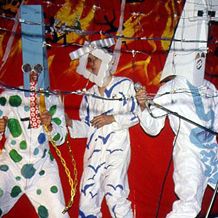
And on it goes. “Mary Mary” by The Prehistoric
New Wave Singers, which opens the B-Side, like their first offering, brings a
pop hit of yore to mind, this time The Monkees, although intentionally more
naively and pre-pubescently executed, of course. Again, the outcome is more
sing-a-long song structured than other offerings found on the album. The German
variant is again more elektronische in delivery, both gloopy and spiky at the
same time, “Es ist Hegel” by Die Karmann Ghias sounding how I imagine Dr. Who’s
Daleks would have were they German, lysergically charged and let loose with a bunch of synthesizers
and such like effect creating devices. Die Schwingerschnitzel then re-appear with
another squeaky ditty. Unsurprisingly, a number of the tracks clock in at under
two minutes (sometimes under one) as does the one just mentioned and the two
that follow, by Die Karmann Ghias and Wonders of Science, and are sometimes more
like sketches rather than fully-formed entities, all the while, though,
supporting the spirit of the genre. “Why Don’t We Dance” by Weltaufstandsplan
is longer, though, and reminds me a little of a track from the first Der Plan 7”,
recorded when their line-up was more fluid, as was their sound, in its
powerful, sinister abstraction. Sinister is also a word I would use to describe
“Mommy Says” by The Prehistoric New Wave Singers, the swampy music rumbling and
occasionally soaring whilst a childlike vocalist whines and laments a tale of
pain, domestic abuse and death, the lyrics barely audible, even if you strain. Then
the set (is it right to call it that?) ends with a genuine Residents connection,
as the departure track “Abschied” is credited as a collaboration between Der
Plan and N. Senada, the “Bavarian composer and music theorist”, who was conjured up, my research tells me, by those mysterious S.F. residents and rumoured
in some parts to be none other than Captain Beefheart. It’s a valedictory, quite
chirpy for these bedfellows, yet rather unstable, whistled piece of lightweight
almost tunefulness, accompanied by what sounds like a piano and one or two
other less classical elements, I assume. It certainly leaves everything hanging
in a state of confusion which, of course, invites another listen to Side A and
then Side B again.
Like so many releases
on vinyl these days, “The Sound of Geri-Reig” is a limited edition, this time to five
hundred numbered copies, and a short promo video exists in cyberland to whet the
appetite of potential punters. Here it is.

Yes, yes, where do I get it?
ReplyDeleteYou can get it directly from the record company: http://www.kernkrach.de/
DeleteAta Tak are also selling it: http://www.atatak.com/
I got mine from Enfant Terrible: www.enfant-terrible.nl
Great video excavated from the vaults of Second Life!
ReplyDeletehappyhappyhappy... today i am the lucky recipient of this wonderful album... coloured vinyl and #ed... what can i ask more... happyhappyhappy... :)
ReplyDeleteSucks
ReplyDeleteThere is absolutely nothing good about this record except for the art and the music!